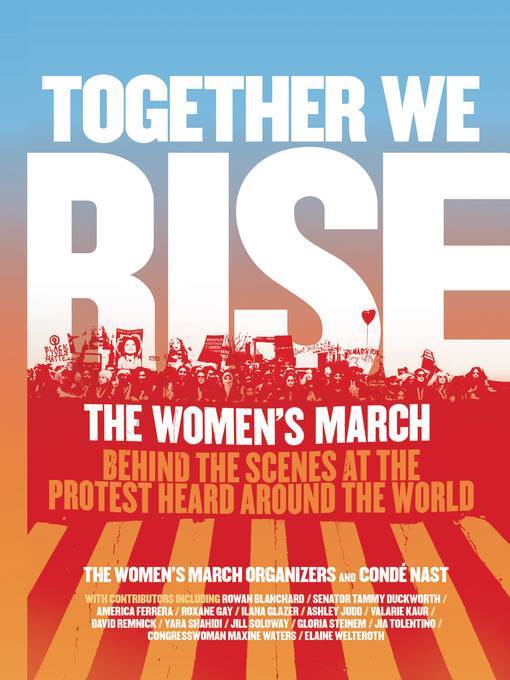
Together We Rise
Behind the Scenes at the Protest Heard Around the World
- اطلاعات
- نقد و بررسی
- دیدگاه کاربران
نقد و بررسی

December 15, 2017
Moving photographs and essays celebrate a powerful protest.Hoping to revive the energy and commitment of the Women's March on Washington of Jan. 21, 2017, the organizers have compiled a profusely illustrated volume of interviews, commentary, and essays, documenting the complex process of making the event a reality and the impact of participating. After Donald Trump's election, one woman in Hawaii, feeling despondent and hopeless, posted an idea on Facebook: "I think we should march," she wrote, immediately gaining the attention of a few dozen friends. By the next morning, 10,000 women had signed on, and the number began to grow, with other groups in several cities making plans independently. Then a few experienced organizers jumped in as coordinators. Immediately, it generated controversy. Black women objected to the name, which recalled the 1997 Million Woman March, focused on "uniting and empowering women of color." The name was quickly changed, and inclusion became vital to planning and participation; soon the initial organizers learned the significance of terms such as "intersectional," "white privilege," and "racial justice." Devising the Women's March platform meant being sensitive to the concerns of Black Lives Matter and criminal justice reformers as well as those of immigrant, Native-American, LGBTQ, and disabled communities. Social justice activists, politicians, strategists, and diverse members of the arts community all contributed as planners under the auspices of the nonprofit Gathering for Justice, an organization started by Harry Belafonte. It soon became clear that the Women's March was igniting resistance throughout the world. More than 3 million people marched across the United States (1 million in Washington, D.C.) and 5 million worldwide. On the National Mall, organizers were stunned when they looked out over the massive crowd. Eloquent essays and comments by participants, including celebrities such as Ashley Judd, America Ferrara, Maxine Waters, and New Yorker editor David Remnick, speak to their deep emotional response to the march. Urging continued activism, the editors offer a list of organizations in which to get involved.An inspiring commemoration of a historic event.
COPYRIGHT(2017) Kirkus Reviews, ALL RIGHTS RESERVED.

January 29, 2018
This photo-filled book of the 2017 Women’s March offers a vivid account of the conception, planning, and staging of the massive demonstration in Washington, D.C. In a patchwork quilt of firsthand accounts, the narrative details the collective grassroots efforts that went into obtaining permits, booking speakers, and arriving at a joint vision for the tone and messaging of the march. In addition to contributions by the event’s organizers, the book features essays by a number of notable figures, including cultural critic Roxane Gay, actor America Ferrera, and Teen Vogue editor-in-chief Elaine Welteroth. Readers who took part in the march will recognize the burgeoning, organic energy that drew so many people to participate. Aerial photos of seas of pink hats capture the scope of the event, while portraits of proud marchers holding signs that read “hope,” “love,” and “defend dignity” capture its immediacy. The authors deliver a sense that the march came about because of a perfect storm of circumstances, a confluence of energy and collective outrage, yet it’s clear in the sections concerning the event’s impact that it was also the galvanizing start of a movement. In commemorating this momentous day, the book also serves as a blueprint for 21st-century protests.

February 15, 2018
The organizers of the women's march here collaborate with publisher Conde Nast to create a lavishly illustrated look back at the January 21, 2016, event released in time for its first anniversary. Insistently multivocal, this collage of oral histories is narrated by the organizers, with personal essays by both high-profile and everyday marchers, and includes a rich collection of images from women's marches from across the globe. Organized in three broad sections, this book explores how the protest came together, the event itself, and the organizers' efforts to support participants' political engagement in the weeks and months that followed. The final section provides a directory of organizations through which readers can take action. The result is a work that resists developing a single authoritative account of the march and instead shares a multitude of stories and images that together become a whole. VERDICT This book will lend itself to casual browsing as well as a more serious study of successful, intersectional grassroots organizing.--Anna J. Clutterbuck-Cook, Massachusetts Historical Soc.
Copyright 2018 Library Journal, LLC Used with permission.

July 1, 2018
This oral history of the 2017 Women's March allows the organizers to tell their story "so that no historian, pundit, or politician could claim what was ours." Opening with election night and an idea posted to Facebook, this title follows the efforts that went into making the march happen, with emphasis placed on the women of color involved in leadership and the work done to ensure the march would be intersectional. It chronicles the day of the Women's March, which ended up being the "single largest protest in world history," with five million participants on all seven continents. The volume is heavily illustrated with large, compelling photographs of the planning and the marches. Pullout boxes and pages let others share their memories and reflect. While the format lends the text an unvarnished intimacy, it does not allow for context. The organizers own up to mistakes and offer rebuttals to some of the criticisms of the march (for instance, a lack of inclusivity), but the book assumes that readers remember those missteps and the larger conversations around them. VERDICT The high-profile rise in teen activism makes this engaging account a solid choice for general collections.-Jennifer Rothschild, Arlington County Public Libraries, VA
Copyright 2018 School Library Journal, LLC Used with permission.




دیدگاه کاربران